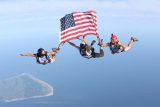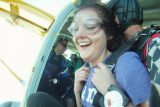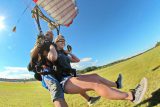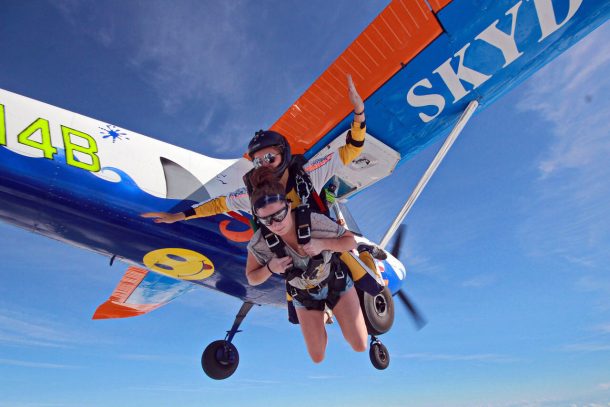What Is A Skydive Landing Like?
Skydiving Information
Posted by: SCC ADMIN
8 years ago
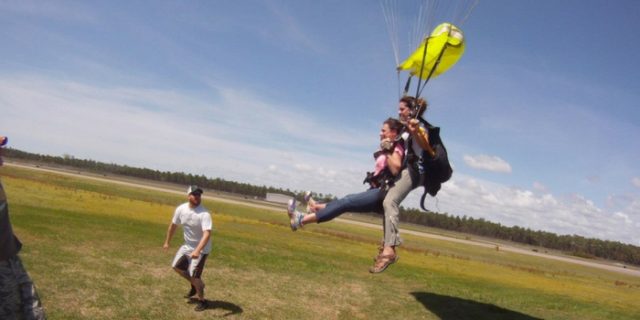
Skydiving landings are controlled arrivals, using inputs on the parachute to slow forward and downward movement. Most skydiving landings are very gentle with the skydiver touching down on their feet or buttocks. Skydivers are taught to land into the wind where possible, which further aids the landing process.
If you’ve ever thought about making a skydiving yourself, it’s likely you’ve thought about freefall. You’ll have thought about what it’ll be like to exit the aircraft, how the wind will hit your face, what the sounds might be like and how it will all feel.
Far fewer people will have thought about the landing or even the parachute ride more generally. Here, we’ll explain what you can expect on your skydiving landing.
WHAT TO EXPECT ON A SKYDIVING LANDING
It’s a common misconception that skydiving landings are lacking in control and involve heavy impact. It’s a misconception that comes from military times and many movies, where what you see is people flying now outdated parachute designs that did result in less comfortable arrivals.
Today’s modern parachute has evolved a long way from the early days of round parachutes and heavy landings, as we’ll go on to explain. If you’re coming to make a skydive with us now, you can expect of your landings:
- Reduced descent and forward motion as you get closer to the ground
- To land on either your feet or your buttocks, depending on the conditions
- To be met by ‘catchers’ who will help to deflate your parachute if you have made a tandem skydive and the winds are slightly higher
All this means that you can expect a comfortable arrival back to earth. On tandem skydives, the whole process is managed by your tandem skydiving instructor, so tandem skydiving landings are even easier! All you’ll need to do is ensure you lift your legs for landing – which is something that will be covered in your tandem skydiving brief.
THE EVOLUTION OF PARACHUTE LANDINGS
One of the biggest innovations in the sport of skydiving came in the 1970s, when the design of parachutes was overhauled. Old style skydiving parachutes were round, meaning they tended to fall almost straight down, and controlling them was very limited – with the pilot only being able to pivot the parachute around its center point.
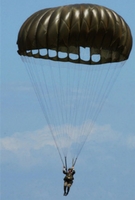
Modern parachutes are what we call ‘square’ (though to look at, they are rectangular). This new design is much more like a wing, using a ram-air system to push air in through openings along the front side, keeping the parachute rigid.
Square, or ram-air, parachutes are much more controllable. Using steering lines located toward the rear of the parachute, along with inputs on the webbing that connects the parachute to the harness (called ‘risers’), the skydiver can control their direction and rate of descent.
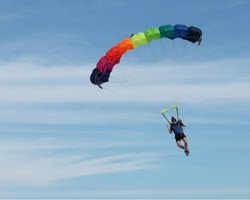
This means that a skydiver can travel much further across the ground under their parachute, and can be incredibly accurate on where they land.
The square design also means that the skydiver can slow the rate of descent of their parachute as they approach the ground – which wasn’t possible with round parachutes. This makes landing a parachute much softer and more predictable. You’ll usually see skydivers touching down gently onto their feet, sometimes running off any remaining forward momentum. It’s a huge difference from old style parachutes, which more often than not resulted in the skydiver hitting the ground with some force and having to roll it off in a ‘parachute landing fall (PLF)’ maneuver.
TANDEM SKYDIVING LANDINGS
A tandem skydiving landing is much like those made by sports parachutists. The tandem skydiving parachute is the same square design, though typically tandem parachutes are much larger and more docile than their sports counterparts.
Though your tandem instructor may invite you to take control of the parachute up high, perhaps letting you instigate a turn, for example, they will take back full control for the landing. This is because they are fully trained and experienced in flying the parachute to the specified landing area, turning it to face into the wind where possible and using inputs on the steering lines to slow the parachute down to land.
You may see tandem skydiving instructors having to put in quite a bit of muscle force at this point! That’s because the size of the tandem parachute means it is much ‘heavier’ to fly than a smaller sports parachute. But don’t worry, all of our instructors are more than capable of bringing the parachute to a stop!
SKYDIVING LANDING TIPS
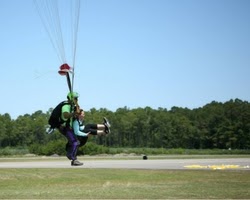
Many skydiving centers, like Skydive Coastal Carolinas, are members of the United States Parachute Association (USPA). The USPA is a body which provides guidelines to help us stay safe, as well as governing the training and qualification processes that mean we can become qualified skydivers and instructors.
The USPA provides the following guidelines for skydiving landings:
- Land under a flat and level parachute, which is not turning at the point of reaching the ground.
- Land in a clear, open area, free of hazards (remember, skydivers have full control over their parachutes, so this should always be possible).
- Use inputs on the parachute to bring it to a slow stop.
- Prepare to use the PLF maneuver to absorb any impact should anything not go to plan.
Using these landing priorities helps skydivers to mitigate as much risk as possible on their landings. As a tandem skydiver, your tandem skydiving instructor will be responsible for flying the parachute and landing it.
Want to experience a skydiving landing for yourself? Book your skydive with Skydive Coastal Carolinas today.
